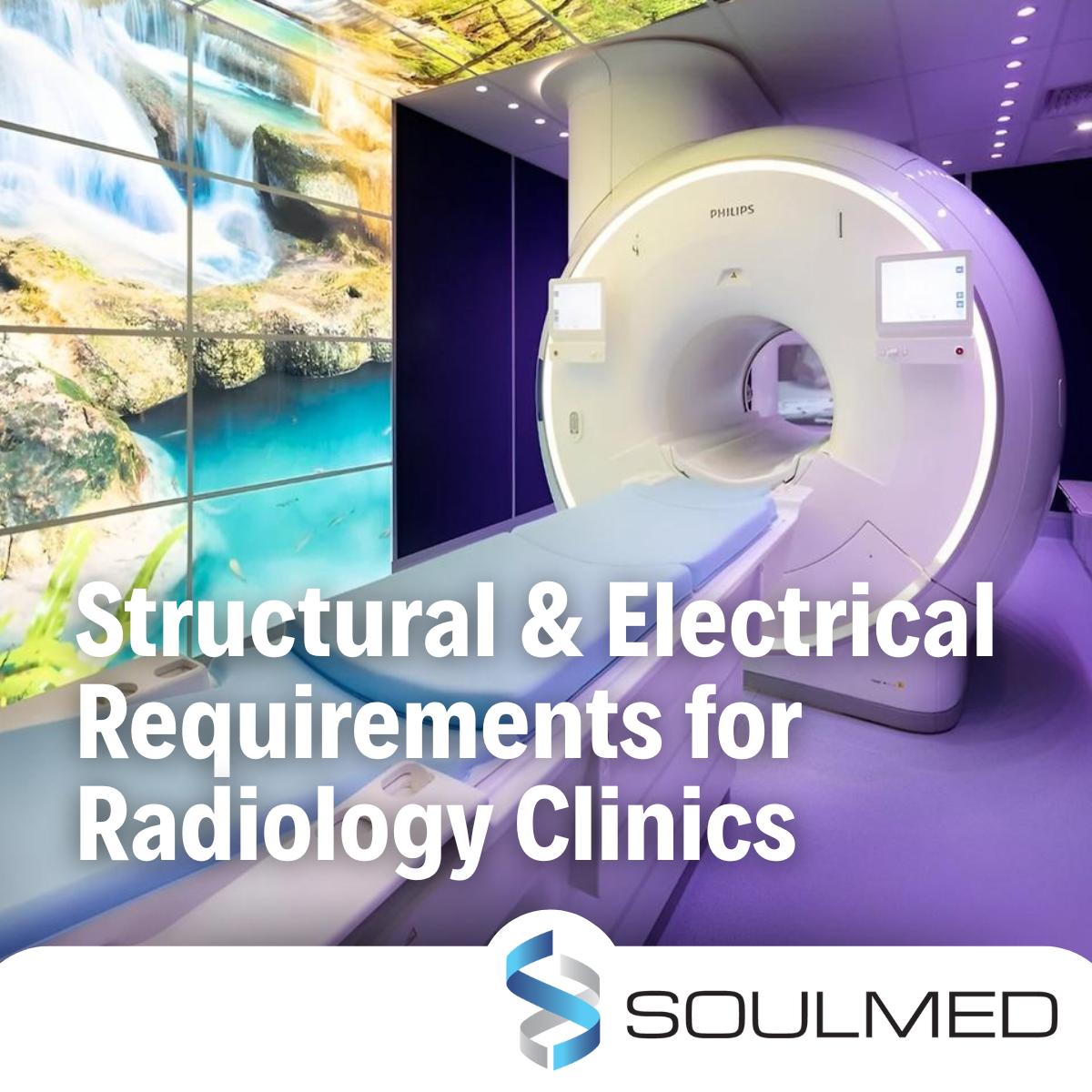Why Structural Planning Matters in Radiology Fitouts
A radiology clinic isn’t just another medical space — it’s a precision-built environment designed to house some of the heaviest, most sensitive equipment in healthcare.
CT scanners, MRIs, and fluoroscopy units can weigh between 1,500–8,000 kg, requiring reinforced floors, specialist electrical feeds, and vibration control to ensure accurate imaging and safe operation.
Before any walls go up, you need a structural and electrical strategy that can handle both weight and electromagnetic sensitivity — while meeting Building Code of Australia (BCA) and radiation safety regulations.
At SoulMed, our design and construction teams specialise in aligning architectural intent with engineering performance to avoid costly rework or compliance setbacks.
1. Structural Considerations: Weight, Vibration & Shielding
a. Floor Loading
MRI and CT machines can exceed 7,000 kg, which means not every commercial tenancy is suitable.
Our structural engineers assess:
- Slab thickness (usually 200–250 mm minimum for MRI rooms)
- Load-bearing capacity — ideally 7.5–10 kPa for imaging rooms
- Equipment distribution — ensuring load is spread evenly beneath magnet or gantry footprints
Learn more about SoulMed’s Medical Construction Services and how we manage heavy-equipment integration from early design.
b. Vibration & Acoustic Isolation
MRIs are magnetically and acoustically sensitive. Even minor vibration from adjacent rooms, lifts, or traffic can distort image quality.
Solutions include:
- Anti-vibration floor mounts
- Isolation pads or inertia slabs
- Acoustic panelling and door seals
c. Radiation Shielding
Although shielding primarily involves lead or high-density plasterboard, its weight and location affect the building structure. Walls and ceilings often require steel stud reinforcement or blockwork bracing to support lead sheets up to 2 mm thick.
Read our guide on Radiation Shielding in Radiology Fitouts for detailed compliance steps.
2. Electrical Infrastructure: Powering Precision Equipment
a. Dedicated Circuits & Voltage Stability
Radiology systems demand dedicated, isolated power circuits with clean voltage. A typical MRI may need:
- 400V three-phase supply
- 80–120A rating
- Separate UPS (Uninterruptible Power Supply) for consoles and PACS systems
Before final design, SoulMed coordinates directly with imaging suppliers (GE, Siemens, Philips, Canon, etc.) to ensure all electrical specs match site capacity.
b. Earthing, Bonding & RF Shielding
MRI rooms must maintain Faraday shielding to prevent external radio interference.
That means:
- Copper or aluminium RF cage lining in walls, ceiling, and floor
- Special door and window assemblies with continuous conductive bonding
- Dedicated equipotential earthing system for patient and equipment safety
See ARPANSA MRI Safety Guidelines for Australian radiation protection and MRI standards.
c. Backup Power & Redundancy
Downtime in radiology = lost revenue and disrupted patient care.
A good electrical design includes:
- Backup generators or UPS for key imaging rooms
- Dual feed systems for reporting servers
- Surge protection on all sensitive devices
See how we integrate these systems in our Radiology Fit-Out Projects in Victoria.
3. Coordination Between Builder, Engineer & Equipment Vendor
The most common cause of radiology delays? Late vendor coordination.
Manufacturers provide “site readiness” manuals detailing room sizes, penetrations, power, cooling, and load requirements. These specs must be integrated before construction drawings are finalised — not after framing.
SoulMed’s process includes:
- Vendor liaison (GE / Siemens / Philips / Canon)
- 3D clash detection with MEP services
- Compliance review under AS/NZS 3000 (Wiring Rules) and BCA Volume 1
- Building surveyor consultation pre-permit
Explore our Design & Construction Process for Medical Fitouts.
4. Cooling & Environmental Controls
Radiology suites generate heat — especially CTs and MRIs.
Chillers, split systems, and water-cooled condensers are often needed to maintain stable operating temperatures.
Design must allow:
- 24/7 cooling with dedicated AHU (air handling unit)
- Redundant systems for sensitive modalities
- Condensate drainage isolated from medical waste systems
Refer to Health VIC HVAC Design Standards for environmental control requirements in imaging suites.
Learn about SoulMed’s Mechanical Services & Compliance Solutions.
5. Compliance Frameworks & Approvals
Your design must align with:
- BCA (Building Code of Australia) — structural & fire safety
- AS/NZS 3000:2018 — electrical installations
- ARPANSA Radiation Protection Series — shielding & radiation limits
- DIAS Accreditation Standards — diagnostic imaging compliance
View the Diagnostic Imaging Accreditation Scheme Standards.
Conclusion: Build It Right, Build It Once
Radiology spaces aren’t forgiving of shortcuts.
From slab depth to switchboards, every element must work in harmony to deliver a safe, high-performance imaging environment that meets compliance and manufacturer standards.
At SoulMed, we manage the entire journey — from feasibility and site selection to full design, permits, and construction — ensuring your radiology clinic is built once, right, and ready for the future.
Contact us today to discuss your project:
Get in touch with SoulMed (03) 5900 4964

